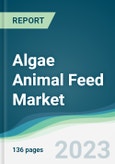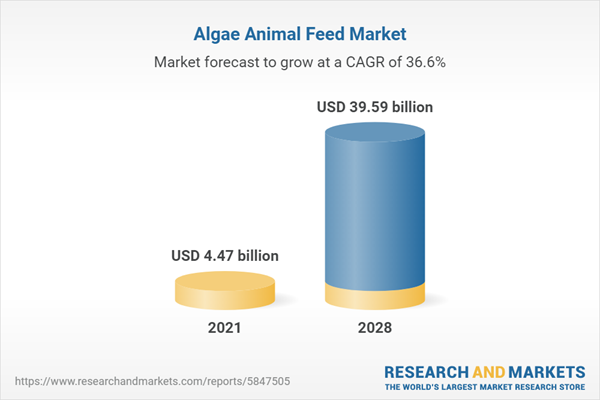The Algae animal feed market was valued at US$4.471 billion in 2021 and is expected to grow at a CAGR of 36.56% to reach US$39.592 billion by 2028.
When seeking a sustainable animal feed alternative, producers are taking into account the use of algae. Animals, including horses, dogs, cats, cows, aquarium fish, and many more, can consume algae since it is high in protein. It has a promising future as animal feed, but more study and development are required before it can be considered a standard product. Protein, antioxidants, fiber, fatty acids, vitamins, and minerals are prevalent in algae feed. These elements assist the animal's body and organs to work properly and contribute to their general wellness. The digestive health of an animal can be improved by feeding it algae. Additionally, it strengthens the animal's defense mechanisms.Rising R&D initiatives and food security and sustainability are expected to fuel the market expansion.
For instance, a research study from Abertay University stated its plans to recycle and reuse the vegetation in November 2022. Their researchers are performing an early feasibility study in collaboration with the decommissioning company CessCon Decom, with funding from the Industrial Biotechnology Innovation Centre (IBioIC). With the help of this effort, algae, corals, seaweed, and mussels discovered on the legs of abandoned oil and gas platforms could be transformed into fresh animal and fish feed. Consuming the right ingredients or nutrients helps domestic animals be stress-free and promotes higher-quality livestock output. Algae have the potential to replace the expensive grains that are now fed to livestock as a high-protein, nutritious, natural, and affordable feeding option. These substances safeguard animals against vitamin deficiencies, accelerate their growth, and enhance their general health and welfare.Additionally, agricultural land usage for animal feed production has been scrutinized due to the increasing water and food shortages. The market for algae-based animal feed and ingredients is anticipated to rise faster due to the rising demand for meat, dairy, and aquaculture products. Furthermore, the booming agriculture sector, animal feed expansion, and expanding consumer spending power all contribute to the market's value expansion. Harvesting algae is a smart way to create animal feed considering the global economic and food crisis. Growing algae for animal food will reduce costs and conserve significant agricultural land and water supplies.
Market Developments:
- Livalta, a division of AB-Agrispecializings in proteins, and Pond Technology Holdings partnered in May 2022 to develop the first CO2-based algae-based animal feed ingredient production that is economically viable. This unique collaboration combined Pond's technology and Livalta's knowledge of novel animal feed proteins. The first Livalta pilot plant was scheduled to be built by Pond at the British Sugar Wissington facility in Norfolk in 2022. With the possibility of more partnerships in the future to build additional production sites, this was to be followed by a commercial-sized plant at the same location that produced 20,000 tonnes of spirulina from CO2 emissions.
The aquaculture sector held a significant share of the algae feed market.
Aquaculture uses algae extensively to improve the salmonids' raised flesh color. It aids in enhancing egg yolk coloring in the poultry business. The demand for aquaculture goods rises as consumers become more aware of the benefits of cutting back on carbohydrates and increasing their intake of protein-rich foods. As a result, salmonid production has grown significantly. The demand for aquaculture ingredients is driven by this, which fuels the expansion of the algal feed business.However, the poultry industry uses microalgae as animal feed since it enhances skin color, shanks, and egg yolks. Ruminants like sheep, goats, horses, and cattle are fed on algae-based animal feed.
Asia Pacific is predicted to witness the fastest growth over the forecast period.
Due to large cattle farms and the rising need for feed ingredients to improve the nutritional content of meat products in the region, North America accounts for a sizeable percentage of the market for algae-based animal feed and components. On the other hand, Asia-Pacific is predicted to experience profitable growth throughout the projection period due to the region's expanding population, the aquaculture industry's exponential growth rate, and shifting consumer trends.Market Segmentation:
By Form
- Algae meals
- Dried algae
- Algae oil
- Algae extract
By Livestock
- Swine
- Poultry
- Aqua
- Others
By Geography
- North America
- USA
- Canada
- Mexico
- South America
- Brazil
- Argentina
- Others
- Europe
- Germany
- France
- United Kingdom
- Spain
- Others
- Middle East And Africa
- Saudi Arabia
- Israel
- Other
- Asia Pacific
- China
- Japan
- India
- South Korea
- Indonesia
- Thailand
- Vietnam
- Others
Table of Contents
1. INTRODUCTION
2. RESEARCH METHODOLOGY
3. EXECUTIVE SUMMARY
4. MARKET DYNAMICS
5. ALGAE ANIMAL FEED MARKET BY FORM
6. ALGAE ANIMAL FEED MARKET BY LIVESTOCK
7. ALGAE ANIMAL FEED MARKET BY GEOGRAPHY
8. COMPETITIVE ENVIRONMENT AND ANALYSIS
9. COMPANY PROFILES
Companies Mentioned
- Cargill Inc.
- Algea
- Alltech
- ADM
- btsa biotecnologias aplicadas S.I.
- Cellana Inc.
- DSM
- Corbion
- Arizona Algae Products, LLC
Methodology

LOADING...
Table Information
| Report Attribute | Details |
|---|---|
| No. of Pages | 136 |
| Published | June 2023 |
| Forecast Period | 2021 - 2028 |
| Estimated Market Value ( USD | $ 4.47 billion |
| Forecasted Market Value ( USD | $ 39.59 billion |
| Compound Annual Growth Rate | 36.5% |
| Regions Covered | Global |
| No. of Companies Mentioned | 9 |









